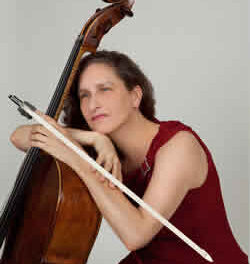There is a brief period of time between the end of academic-year concert series and the beginning of summer events, but even those few weeks elicit panic and withdrawal symptoms among hard-core music lovers. On June 1, Duke Performances presented the first of the 2006 Summer Chamber and Choral Music series with a program called “The Ciompi Quartet & Friends.” Unlike previous summers where the Ciompi Quartet was the main attraction on many concerts, this was the first of only two in which they will participate this year. That, combined with a beautiful late-spring evening, an all-Mozart program, and some very special guest artists, made for a memorable evening. The concert took place at the lovely Doris Duke Center at the Sarah P. Duke Gardens, and the room was filled to the brim, literally. There was such a large turnout that they took the unprecedented step of putting the overflow crowd on the outdoor patio – behind the performers — keeping the door open so they could hear.
Asymmetry in instrumentation was the feature here, as we heard works with three and five strings respectively – not a quartet in sight. String trios have never quite attained the popularity or critical appeal that the string quartet, piano trio, or other chamber music configurations enjoy. Many composers used this format as early compositional training wheels only to abandon the form in their mature style. A huge and significant exception is Mozart’s Divertimento for Violin, Viola and Cello, K.563. Written late in his life, this is a grand work in both length and substance – and one that is rarely performed. There is no room for any player to hide, no incestuous battles between first and second violins, no one instrument is “featured” – this is music in its purest form. Tackling this imposing, but very rewarding task, were three players of varying familiarity to local audiences. Jonathan Bagg, violist, a longtime member of the Ciompi Quartet, is well-known. Alan Black, cello, is Principal Cellist with the Charlotte Symphony and recently served on the faculty of the UNC Chamber Music Festival. Monica Boboc, violin, has a long and distinguished resume of orchestral and chamber music appointments and also now plays with the Charlotte Symphony.
Although I was 20 minutes early, I was still unable to secure a seat with a sightline to the performers (one of the few drawbacks to this venue), so I settled for comfort instead, grabbing a big cushiony chair at the back of the hall. I could not see the players at all – but this was not necessarily a bad thing. Take away one sense and others become sharper and more focused. It is an unusual situation to go to a live concert and not be able to see any of the “stage.” I felt as if I was hearing in a way that I had rarely experienced, and it couldn’t have happened at a better time. Every aspect of musical performance was at the highest level: beautiful, warm sound, impeccable intonation, and a melding of spirit that usually only comes after years of playing together.
Mozart took the standard string quartet form, added a second viola to the mix, and produced six viola quintets that spanned his entire life and that are recognized as some of his greatest creations. The Ciompi Quartet, beefed up with violist Scott Rawls, played the D major quintet – written in 1790. Despite the prime number instrumentation, there is a feeling of balance, musically and visually, that is missing from a quartet. The cello was centered with violins and violas flanking him, and this created a delicious extra voice that often becomes muddied with any more than that. This is chamber music in its truest sense. The audience was within inches of the players, there were people literally on all sides, and there was a combination of informality and reverence for the music that you don’t get in your typical Saturday night theater concert. The work played is classical-style musical genius at its highest level – and we are only left with a “what if” game wondering what more could have been created.
The quartet and Rawls not only turned in an insightful and brilliantly played performance, but they had a great time doing it. That’s what it’s all about!











